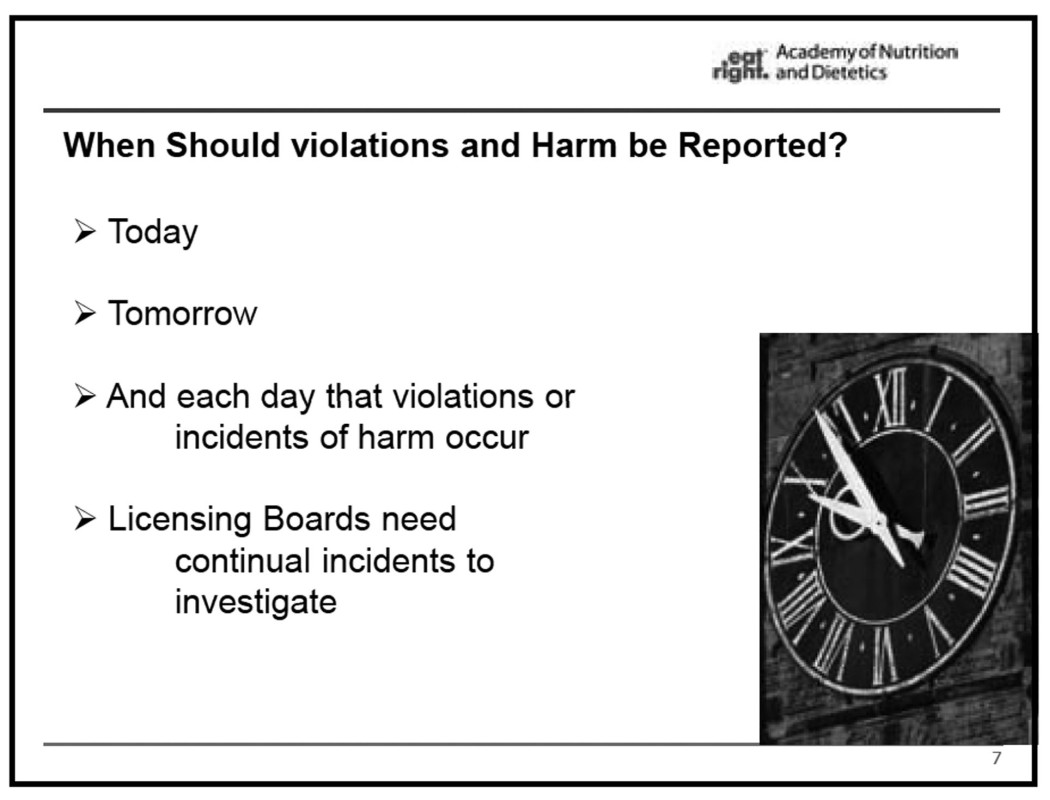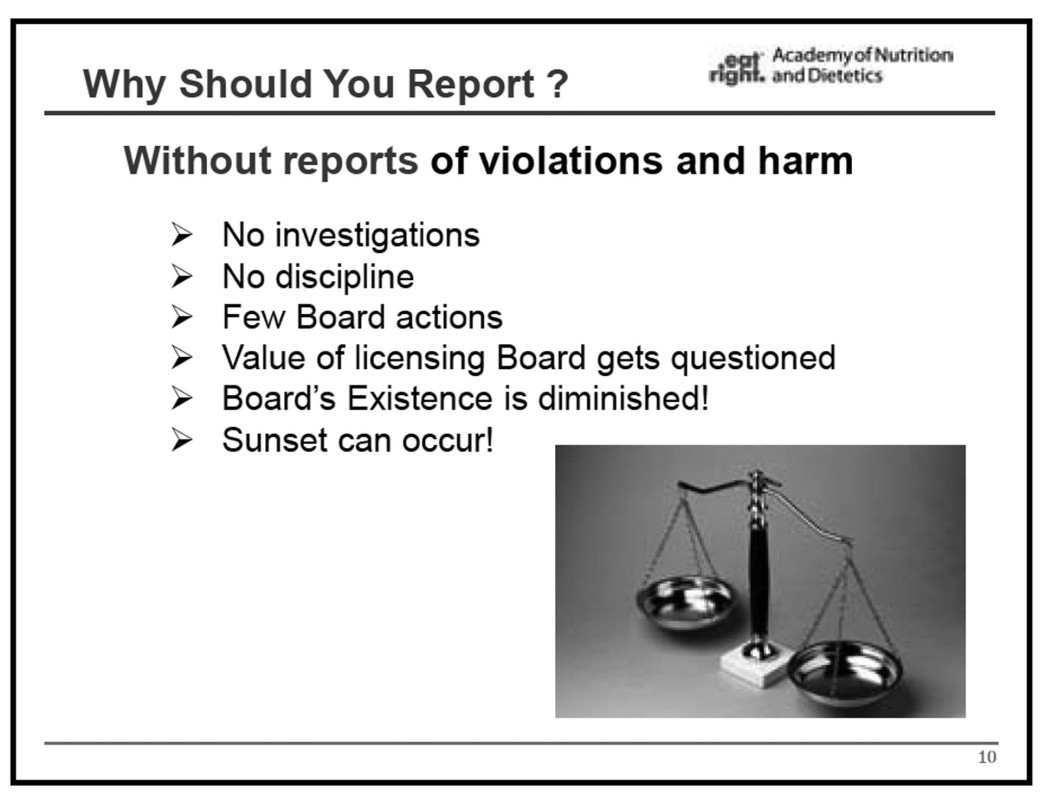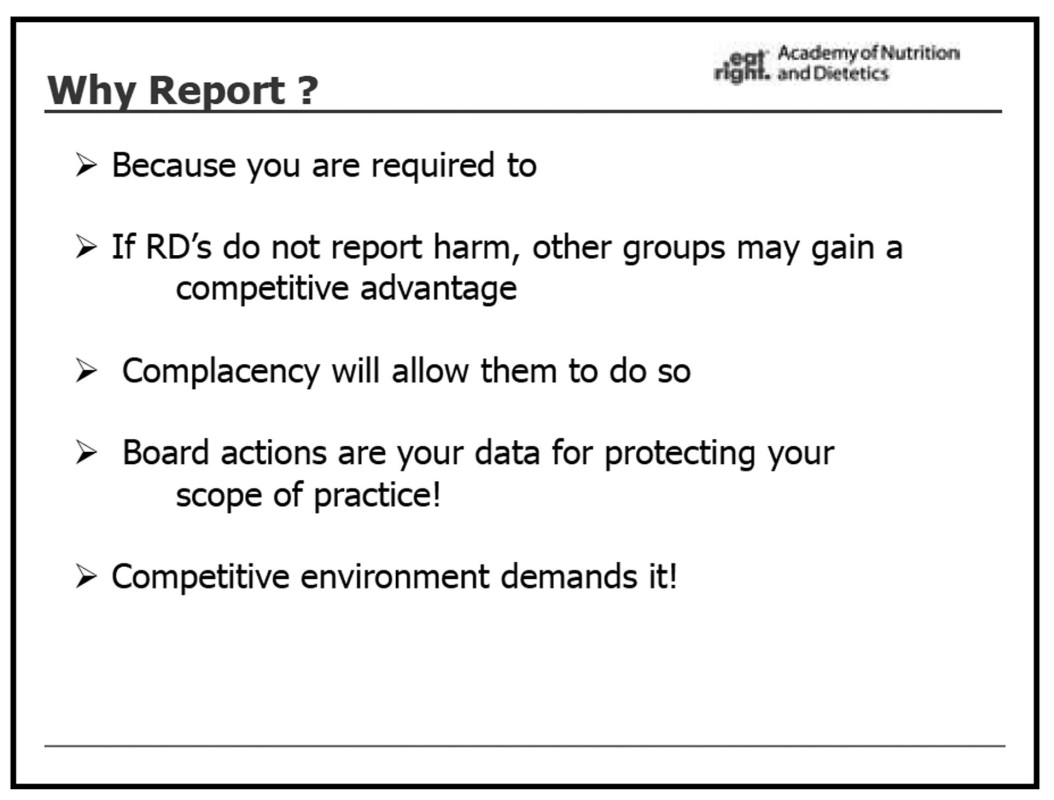Whole (44 page)
Authors: T. Colin Campbell

Unlike most of the people bullied by the dietetic industry, Popper fought back. She spent tens of thousands of dollars of her own money, hired the top lawyers in the state, and ultimately succeeded in legalizing her business in Ohio. In an email, she shared with me a slide presentation given by the former Executive Director of the Ohio Board of Dietetics and current Chair of the AND Licensure Workgroup, Kay Mavko, urging and instructing local dietitians to “turn in” their competition to state licensing boards.
15
Just in case you think I’m being cynical or paranoid about the AND’s real goals, I’ve reproduced a few of the slides in
Figures 18-1 through 18-3
.

FIGURE 18-1.
Slide from an Academy of Nutrition and Dietetics presentation
Note that last bullet in
Figure 18-1
: “Licensing Boards need continual incidents to investigate.” Without continual complaints, the Licensing Boards have nothing to do. Another slide warns of the danger of “sunset”: that idle boards could be dissolved for lack of function. Dietitians must keep them busy! Again, the slide presentation says it far more eloquently than I can; see the slide in
Figure 18-2
.

FIGURE 18-2.
Slide from an Academy of Nutrition and Dietetics presentation
But surely Kay Mavko and the AND are engaging in this witch hunt with good intentions. They’re just trying to protect the public from what they see as bad nutritional advice from those who have not gone through the AND’s rigorous accreditation process. Right? Again, Mavko’s slide presentation sets the record straight. Take a look at the slide in
Figure 18-3
.
If registered dietitians are complacent, “other groups may gain a competitive advantage.” You must protect “your scope of practice.” Wow! You can see why this slide show isn’t on the AND website, and why it was leaked to journalists by renegade AND members who were appalled at the idea of being turned into AND spies.
16
The AND and its state board allies feel threatened by nutrition education that doesn’t toe the official AND line because they fear for their jobs. That’s understandable, as long as the public and regulators realize that the AND is, as Dr. Popper noted, “a trade group, not an authority on nutrition and health.”
17

FIGURE 18-3.
Slide from an Academy of Nutrition and Dietetics presentation
Dr. Popper isn’t, in AND’s eyes, a legitimate source of nutrition information. So who is? The answer turns out to be the same industry and companies that pay the AND’s bills. Some of the education providers approved by CDR include pharmaceutical giant Abbott Labs, food service providers Aramark, Sodexo, and Sysco, and front groups for the junk food industry, including the transparently named Coca-Cola
Company Beverage Institute for Health & Wellness, ConAgra Food Science Institute, General Mills Bell Institute of Health and Nutrition, Kraft Foods Global, Inc., Nestle HealthCare Nutrition, PepsiCo Nutrition, and US Foods.
18
Just in case some junk food manufacturers don’t quite grasp the benefits of becoming an accredited provider of continuing professional education for AND members, the CDR website spells them out clearly under the heading “Marketing Opportunities”:
- “[E]xposure to a market of over 65,000 credentialed dietetics professionals.”
- “[P]romotion of individual CPE [continuing professional education] activities in the CDR CPE Database, which is available to practitioners via mail, fax, phone, and online.”
- [L]isting “as an [sic] CPE Accredited Provider on CDR’s website.”
- “[A]pproval to use the CDR CPE Provider Accreditation logo while marketing CPE activities and materials.”
19
Talk about foxes teaching the hens about security fencing!
It is my experience that the education programs of all-powerful organizations very much defend the status quo, especially the so-called health value of dairy products for young people. They like to claim that they have a vegetarian subgroup in their organization, but it’s treated more like a politically expedient stepchild than a true member of the AND family. As well, vegetarianism is still a far cry from the WFPB nutrition the research recommends; it cuts out meat, but still allows significant amounts of dairy products, eggs, and processed foods that prevent radiant health and freedom from disease.
The AND’s work extends beyond educating (indoctrinating?) dietitians. In 2011, they also donated $62,000 to congressional candidates to promote their political agenda. What a great way for Coca-Cola, Pepsi, and others who donate to the AND to “launder” their political influence! AND, in effect, is turned into a highly credible PR agency for its corporate allies. Through its advocacy, public relations, and mandatory education partners, it serves as a front for the food and drug industries and their interests.
It saddens me to say these things because in my experience, the AND’s individual nutritionist members are the most knowledgeable
professionals on nutrition I meet in my public lectures, skilled at presenting nutritional material to the public and unusually motivated in their work. What I find repugnant is the organizational constraints placed on these members, often without their awareness, about what is and is not acceptable opinion.
I include the ASN (originally the American Institute of Nutrition) in this discussion not because they’re a particularly egregious offender, but because I’m intimately familiar with the subtle and corrosive effect of corporate money on this once-fine organization. To their credit, they have developed a conflict of interest toolkit designed to root out obvious attempts at hanky-panky. Yet the influence of industrial profit is so pervasive within the system that no overt attempts at self-regulation, no matter how sincerely meant, can be truly effective.
I have been a member of this society for forty-five years and was very active in it for many of them. They held their national research meetings in conjunction with five (later six) sister biological societies, collectively known as the Federation of American Societies for Experimental Biology. At their peak, these annual five-day meetings attracted about 20,000 to 25,000 biological scientists. I greatly enjoyed the atmosphere and candid exchanges with colleagues on our research findings. Some of my more memorable recollections are of the awards given to my students, the symposia that I organized or participated in, and the exchange of research ideas in the formal presentations.
However, one thing always bothered me, and it only became worse over the years: the so-called prestigious awards given annually to various established researchers, usually along with award money provided by food and drug companies. Each award was modest, ranging from $1,500 to $5,000 apiece, but in total (approximately $40,000 to $50,000), the awards represented a powerful monetary influence that steered the ASN away from honest statements about nutrition. Industry knows that even small rewards can buy loyalty from researchers who, given a range of topics to
study, simply find it easier and less uncomfortable to pursue research that does not implicate the products sold by their grantors.
When I became more involved in leadership positions of the society, I began to see the much-too-close involvement of these companies in its affairs. One of the more significant, at least for me, was the attempt by certain society members—prominent consultants to the American Egg Board, the General Mills Company, and other industries—to propose having me expelled from the society, the first time such an attempt had been made against one of its members in their forty-year history. Apparently, I had committed the ominous sins of (1) assisting as senior science advisor to the new cancer research organization, the AICR, to focus their efforts on nutrition with a bias toward plant-based foods; and (2) being a prominent member of the 1982 NAS committee on diet, nutrition, and cancer whose report brought focus to the cancer-prevention properties of plant-based foods. After an investigation, the society’s eight-member executive committee voted 6-0 (with two abstentions) to absolve me of any wrongdoing. Still, this was an aggressive attempt by the industry-oriented members to silence me. As you can tell, it didn’t work!
Professional societies protect their existence (and present and future funding) by aligning themselves with the traditional food and drug companies and their interests, avoiding as much as possible any mention of the possible health benefits of the WFPB diet. Having been part of several professional societies, I can assure you that they almost never accept findings that favor such a diet—and this includes the societies to which I have long belonged.
Maybe you’re wondering, what’s the big deal? After all, these societies are free to publish, promote, and pay for any nonsense they like, and so are you and I. Training nutritionists and influencing research scientists isn’t the same as dictating what we eat (how many of us have gone to a nutritionist?); these societies therefore seem easy to ignore. The problem is that because they are empowered by industry funding and granted quasi-governmental status to determine who is allowed to study and teach
nutrition, and who can be marginalized or even disciplined for deviating from the party line, they are able to influence government policy, medical practice, and public perception far out of proportion to their financial weight, and in a number of different ways. I know something about this unprofessional behavior both from their investigation of my professional activities and from my tenure as liaison for the ASN and its sister societies to the budgetary process of the U.S. Congress.
First, they exploit the perception that they occupy some moral high ground in the battle against disease. To oppose them is to lend support to the enemy: the diseases that threaten us and our loved ones. Anyone who has had to explain to a neighbor suffering from breast cancer why they won’t donate money for a pink ribbon, walkathon, race, bake sale, talent show, house party, reading group, or power lunch “for the cure” know the social ostracism that can result. As we’ve seen, most people suffering from a disease, as well as their loved ones, cling to hope in the medical establishment. After undergoing a surgery, drug regimen, radiation, or chemotherapy that improves function and staves off further degeneration, they may become active cheerleaders for current medical practice and evangelists for the “cure around the corner.” Corporations like AstraZeneca and Merck can’t command this passion and activism directly, but through nonprofits they convert well-meaning people’s desperate energy into quarterly profits.
Advocacy and fundraising organizations in particular lay claim to a manufactured legitimacy that they have bestowed upon themselves, and few elected officials, journalists, or business people have the knowledge, incentive, or guts to question those credentials. When ACS puts out a press release, even the most respected journalists abandon impartiality as if they were local sports announcers openly rooting for the home team.
Three cheers for ACS and its success in the War on Cancer, NewsHour
and the rest of the mainstream press echo in tones of awed admiration.